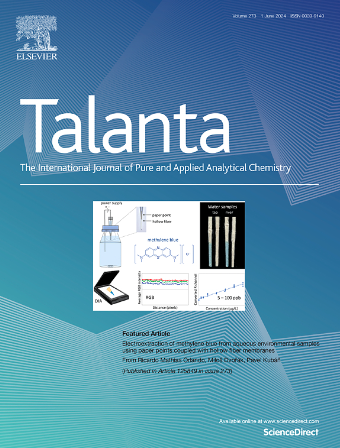利用一次性微流控平台的电化学基因组磁检测SARS-CoV-2 RNA
IF 5.6
1区 化学
Q1 CHEMISTRY, ANALYTICAL
引用次数: 0
摘要
2019冠状病毒病大流行使世界面临历史上最大的挑战之一,造成了深刻的社会和经济影响。随着大流行病的发展,显然需要新的诊断测试来监测和控制该疾病。在这个意义上,我们描述了基于使用全一次性电化学微流控装置检测唾液样本中严重急性呼吸综合征冠状病毒2 (SARS-CoV-2) RNA的基因组遗传分析的发展。结果制备了一种简单、低成本的含碳基电极的一次性微流控平台(DμP),并与含钕磁铁的三维支架偶联,用于检测唾液样品中的SARS-CoV-2 RNA。该设备允许使用基因组磁分析多达8次同时检测,提供灵敏度检测限0.44 fmol L−1和定量限1.44 fmol L−1,线性范围为5.0 fmol L−1至200.0 nmol L−1。该方法已成功应用于COVID-19阳性和阴性个体的队列诊断,与逆转录聚合酶链反应(RT-PCR)结果非常吻合。基因组遗传学分析显示,能够区分健康个体和感染SARS-CoV-2的患者,临床敏感性和特异性分别为82.4%和100.0%。该方法可以简单、低成本、定量检测病毒RNA,不需要转录或DNA扩增步骤,具有良好的重复性。提出的基因组分析方法可以作为新冠病毒诊断和监测的替代工具,甚至可以很容易地用于检测其他单链RNA病毒。本文章由计算机程序翻译,如有差异,请以英文原文为准。

Electrochemical genomagnetic assay for detection of SARS-CoV-2 RNA using a disposable microfluidic platform
Background
The COVID-19 pandemic exposed the world to one of the greatest challenges in our history, causing profound social and economic impacts. With the advance of the pandemic, it became evident that there was a need for new diagnostic tests for monitoring and controlling the disease. In this sense, we describe the development of a genomagnetic assay based on the use of a fully disposable electrochemical microfluidic device for detection of RNA from severe acute respiratory syndrome coronavirus 2 (SARS-CoV-2) in saliva samples.
Results
A simple and low-cost disposable microfluidic platform (DμP) containing unmodified carbon-based electrodes was developed and coupled to a 3D holder containing neodymium magnets for detection of SARS-CoV-2 RNA in saliva samples. The device allows up to 8 simultaneous detections using the genomemagnetic assay, providing sensitivity with a limit of detection of 0.44 fmol L−1 and a limit of quantification of 1.44 fmol L−1, with a linear range of 5.0 fmol L−1 to 200.0 nmol L−1. The proposed assay has been successfully applied for the diagnosis of COVID-19 in cohorts of positive and negative individuals, showing excellent agreement with the results obtained by reverse transcription-polymerase chain reaction (RT-PCR). The genomagnectic assay showed the ability to discriminate between healthy individuals and patients infected with SARS-CoV-2, showing 82.4 % and 100.0 % of clinical sensitivity and specificity, respectively.
Significance
The method developed allows a simple, low-cost, and quantitative detection of viral RNA requiring no transcription or DNA amplification steps showing excellent reproducibility. The genomagnetic assay proposed can be an alternative tool for the diagnosis and monitoring of COVID-19 and even could be easily adapted for detection of other single-stranded RNA viruses.
求助全文
通过发布文献求助,成功后即可免费获取论文全文。
去求助
来源期刊

Talanta
化学-分析化学
CiteScore
12.30
自引率
4.90%
发文量
861
审稿时长
29 days
期刊介绍:
Talanta provides a forum for the publication of original research papers, short communications, and critical reviews in all branches of pure and applied analytical chemistry. Papers are evaluated based on established guidelines, including the fundamental nature of the study, scientific novelty, substantial improvement or advantage over existing technology or methods, and demonstrated analytical applicability. Original research papers on fundamental studies, and on novel sensor and instrumentation developments, are encouraged. Novel or improved applications in areas such as clinical and biological chemistry, environmental analysis, geochemistry, materials science and engineering, and analytical platforms for omics development are welcome.
Analytical performance of methods should be determined, including interference and matrix effects, and methods should be validated by comparison with a standard method, or analysis of a certified reference material. Simple spiking recoveries may not be sufficient. The developed method should especially comprise information on selectivity, sensitivity, detection limits, accuracy, and reliability. However, applying official validation or robustness studies to a routine method or technique does not necessarily constitute novelty. Proper statistical treatment of the data should be provided. Relevant literature should be cited, including related publications by the authors, and authors should discuss how their proposed methodology compares with previously reported methods.
 求助内容:
求助内容: 应助结果提醒方式:
应助结果提醒方式:


